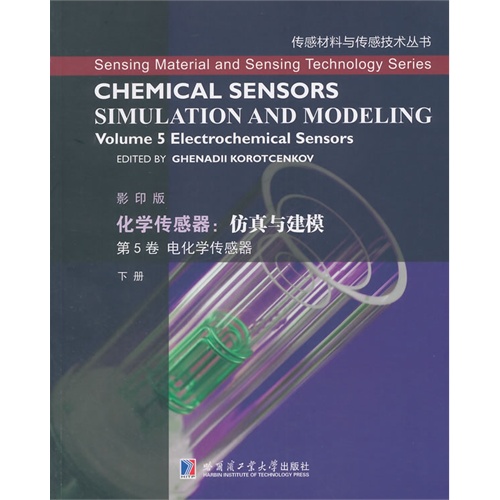
第5卷 电化学传感器 下册-化学传感器:仿真与建模-影印版

- ISBN:9787560348995
- 装帧:一般胶版纸
- 册数:暂无
- 重量:暂无
- 开本:16开
- 页数:408
- 出版时间:2015-01-01
- 条形码:9787560348995 ; 978-7-5603-4899-5
本书特色
this series,chemical sensors:simulation and mod.eling,is the perfect complement to momentum press's six-volume reference series,chemical sensors:fundamentals of sensing materials and chemical sensors: comprehensive sensor technologies,which present detailed information about materials,technologies,fabrication,and applications of various devices for chemical sensing.chemical sensors are integral to the automation of myriad industrial processes and everyday monitoring of such activities as public safety,engine performance,medical therapeutics,and many more.
内容简介
This series,Chemical Sensors:Simulation and Mod.eling,is the perfect complement to Momentum Press's six-volume reference series,Chemical Sensors:Fundamentals of Sensing Materials and Chemical Sensors: Comprehensive Sensor Technologies,which present detailed information about materials,technologies,fabrication,and applications of various devices for chemical sensing.Chemical sensors are integral to the automation of myriad industrial processes and everyday monitoring of such activities as public safety,engine performance,medical therapeutics,and many more.
目录
about the editor
contributors
part 3: electrochemical biosensors
7 nanomaterial-based electrochemical biosensors n.jaffrezic-renault
1 introduction
2 nanomaterials: fabrication, chemical and physical properties
2.1 conducting nanomaterials
2.2 nonconducting nanomaterials: magnetic nanoparticles
3 conception and modeling of amplification effect in nanomaterial-based enzyme sensors
3.1 aunps-based amperometric sensors
3.2 cnt-based amperometric sensors
3.3 mnp-based amperometric biosensors
3.4 potentiometric sensors
3.5 conductometric and impedimetric biosensors
4 conception and modeling of amplification effect in nanomaterial-based immunosensors
4.1 aunp-based amperometric immunosensors
4.2 aunp-based potentiometric sensors
4.3 impedimetric sensors
4.4 conductometric sensors
5 conception and modeling of amplification effect in nanomaterial-based dna biosensors
5.1 amperometric sensors
5.2 impedimetric sensors
6 conclusion
references
8 ion-sensitive field-effect transistors with nanostructured channels and nanoparticle-modified gate surfaces: theory,modeling and analysis
v k. khanna
1 introduction
2 structural configurations of the nanoscale isfet
2.1 the nanoporous silicon isfet
2.2 the cnt isfet
2.3 the si-nw isfet
3 physics of the si-nw biosensor
3.1 basic principle
3.2 analogy with the nanocantilever
3.3 preliminary analysis of micro-isfet downscaling to nano-isfet
3.4 single-gate and dual-gate nanowire sensors
3.5 energy-band model of the nw sensor
4 nair-alam model of si-nw biosensors
4.1 the three regions in the biosensor
4.2 computational approach
4.3 effect of nanowire diameter (d) on sensitivity at different doping densities, with air as the surrounding medium
4.4 effect of nanowire length (l) on sensitivity at different doping densities, with air as the surrounding medium
4.5 effect of the fluidic environment
4.6 overall model implications
5 ph response of silicon nanowires in terms of the site-binding and gouy-chapman-stern models
6 subthreshold regime as the optimal sensitivity regime of nanowire biosensors
7 effective capacitance model for apparent surpassing of the nernst limit by sensitivity of the dual-gate nw sensor
8 tunnel field-effect transistor concept
9 role of nanoparticles in isfet gate functionalization
……
9 biosensors: modeling and simulation of diffusion-limited processes
index
作者简介
Ghenadii Korotcenkov,received his Ph.D. in Physics and Technology of Semiconductor Materials and Devices in 1976, and his Habilitate Degree (Dr.Sci.) in Physics and Mathematics of Semiconductors and Dielectrics in 1990. For a long time he was a leader of the scientific Gas Sensor Group and manager of various national and international scientific and engineering projects carried out in the Laboratory of Micro-and Optoelectronics,Technical University of Moldova.Currently, Dr. Korotcenkov is a research professor at the Gwangju Institute of Science and Technology,Republic of Korea. Specialists from the former Soviet Union know Dr. Korotcenkov's research results in the field of study of Schottky barriers,MOS structures, native oxides,and photoreceivers based on Group III-V compounds very well. His current research interests include materials science and surface science,focused on nanostructured metal oxides and solid-state gas sensor design. Dr. Korotcenkov is the author or editor of 11 books and special issues,11 invited review papers,17 book chapters,and more than 190 peer-reviewed articles. He holds 18 patents,and he has presented more than 200 reports at national and international conferences. Dr. Korotcenkov's research activities have been honored by an Award of the Supreme Council of Science and Advanced Technology of the Republic of Moldova (2004),The Prize of the Presidents of the Ukrainian, Belarus, and Moldovan Academies of Sciences (2003), Senior Research Excellence Awards from the Technical University of Moldova (2001,2003,2005),a fellowship from the International Research Exchange Board (1998), and the National Youth Prize of the Republic of Moldo
-

黑科技驱动世界的100项技术
¥30.5¥69.8 -

欧亚草原古代治金
¥70.6¥98.0 -

船舶综合驾驶台通信与导航系统:::
¥41.8¥58.0 -

对口升学考试全真模拟试卷 机电与机制类专业
¥25.4¥39.0 -

房树人绘画投射测验——临床应用实践手册
¥62.4¥78.0 -

铁道之旅:19世纪空间与时间的工业化
¥20.7¥59.0 -

工业聚乙烯导论
¥77.4¥98.0 -

煤矿工人情景意识的fnlrs脑功能连接特征与分类识别研究
¥53.7¥88.0 -

(教材)产业用纺织品实验教程
¥41.8¥58.0 -

作战无人机系统和全球作战无人机
¥139.5¥186.0 -

多媒体多模态融合的情感分析网络
¥21.5¥29.0 -

机床维修电工(第3版)
¥23.4¥39.0 -

从模仿到创新:苏联液体弹道火箭技术的发展1944-1951
¥55.4¥88.0 -

熔喷非织造成形理论
¥65.3¥99.0 -

《煤矿地质工作细则》释义
¥27.4¥48.0 -

生命教育丛书:防灾避难与危机处理
¥22.4¥49.8 -

制药工艺学(姚日生)
¥35.3¥49.0 -

产业用纺织品实验教程
¥53.0¥78.0 -

工贸行业重大风险辨识评估与分级管控
¥64.2¥88.0 -

复合材料数字化研制与工程实战
¥124.6¥178.0









